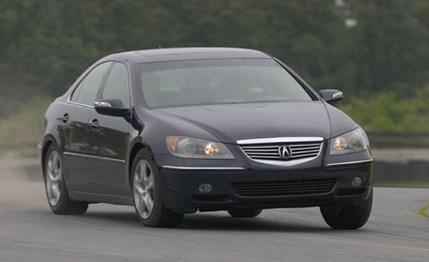
 First Drive Review
First Drive Review
Honda was the first Japanese automaker to challenge the luxury-car establishment—epitomized at the time by BMW and Mercedes—with its Acura line in 1986. It drove a wedge into this profitable segment with its Legend and, over the years, secured its position with a succession of vehicles that sold well and were favorably reviewed; in recent times Acuras have been regular residents on our 10Best list.
Despite its success, Acura never quite attained the prestige of the traditional luxury brands—J.D. Power usually ranked its cars in a near-luxury category—nor did it produce any iconic models, with the exception of its world-class sports car, the NSX.
The fault did not lie in what Acura submitted—its cars were always well built and fitted with the requisite allotment of polished wood, soft leather, and other luxury accouterments—but in what it omitted. There was no Acura to match a Mercedes S-class, or a BMW 7-series, or a Lexus LS sedan. Forget a V-12 option—Acura didn't even offer a V-8. Nor was there a rear-drive model, save for the NSX. It's a perception thing, to be sure, but in the luxury-goods business, perception is everything—it's the difference between a Timex and a Rolex, each of which serves the same function equally well.
With the introduction of this RL sedan, however, the perception of Acura as being not ready for admission to the high-rollers club may get a rethink—well, for medium rollers, anyway, since it competes against the likes of BMW's 5-series and Mercedes' E-class. Still, this is the first Acura sedan that can belly up to the no-limits table with the major players.
The main reason the RL deserves such consideration is something Acura modestly calls Super-Handling All-Wheel-Drive (SH-AWD). By itself, this system would give the RL parity with its rear- and four-wheel-drive competition. But when you add to that 300 horsepower and some elegant engineering, it makes the car somewhat more than equal.
SH-AWD eliminates some four-wheel-drive staples such as conventional center and rear differentials. Instead, it uses a pseudo rear diff with two electromagnetic clutches that control torque distribution on the orders of a computer that monitors front and rear g-forces, yaw, steering input, rpm, throttle position, gear ratio, and individual wheel speeds. As you cruise along, the system pumps 70 percent of the power to the front wheels. But as conditions change, it can reverse the balance to the rear wheels, pretty standard four-wheel-drive stuff. What's different about the SH-AWD is its ability to apportion torque side to side on the rear axle. In fact, the system can route as much as 100 percent of the rear axle's power to just one rear wheel if necessary. The torque-shifting function is tied into the vehicle's stability-control system and is designed to give the RL agile yet foolproof handling.
All this power mongering is never apparent to the driver, but its effect is obvious. This we discovered in the course of running dozens of laps in several RLs around a tight little circuit at Summit Point Raceway in West Virginia.
Driven quickly but short of its limits, the RL's steering is responsive. The car is well balanced and feels as solid and safe as an investment in Honda stock. Pushed harder into turns, it eases into understeer, which can be moderated by feathering the throttle or taking a slightly wider line. If you get back on the power either too hard or too early in exiting a turn, you will transition into a four-wheel drift, at which point the car can be easily throttle-steered into the next straight stretch. Although this isn't the quickest way around, it's kind of fun. But try as we did, we could never bull the RL into the dramatic opposite-lock, power-oversteer slide so beloved by photographers. The SH-AWD frowns on such shenanigans and simply will not allow them; with its electronics and mechanicals toiling mightily away, the RL is so tightly reined in that it seems incapable of unpleasant surprises.
In the straight stretches between turns, the RL was quick, sounded appropriately authoritative, felt as firm as a Bradley fighting vehicle, and revealed no untoward traits. With the aforementioned 300 horsepower and 260 pound-feet of torque, its 3.5-liter VTEC V-6 engine is never lacking. Its five-speed automatic transmission shifts imperceptibly and can be manually controlled by either a floor shift or paddles on the steering wheel.
After lots of track time, the RL's steering began to feel a bit light and its suspension too soft—there's certainly room for Acura to add a more stiffly sprung sport model down the line—but as the red mist receded and we headed back to the highway, the RL resumed being what it is, a comfortable luxury car.
As such, the RL is packed with standard items (there are no options) that include all the power-operated gadgets one expects but adds an interesting new item called AcuraLink, which uses the same satellite signal as the car's XM radio to graphically display on the navigation screen real-time traffic conditions in 20 U.S. metro areas.
The price for all this? "Significantly under $50,000," according to Tom Elliott, Honda's executive V-P of auto operations. Definitely luxury-car territory.